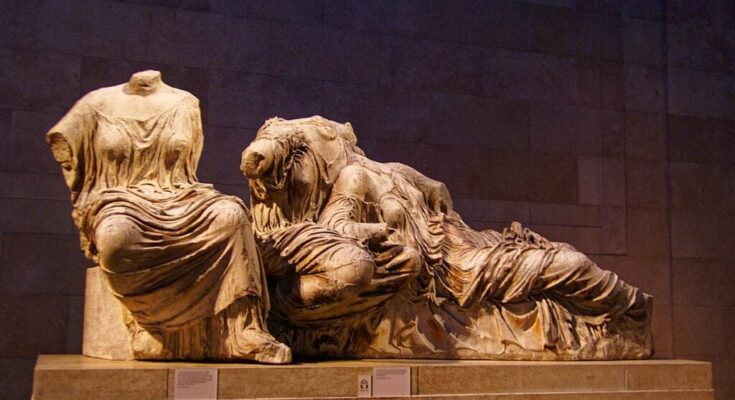
Recent evidence says that the Parthenon sculptures were colorful and had detailed designs with human figures and palm leaf patterns. This revelation comes from a study published in the journal Antiquity. Researchers used advanced scanning technology to closely examine the surfaces of sculptures housed at the British Museum, revealing traces of paint and carvings.
The examination indicated that the ancient artisans had adorned the sculptural surfaces with textures mimicking specific materials like leather, wool, and linen. These textures were then enhanced with pigments, notably a purple hue and Egyptian blue. This artificial dye was widely used in antiquity for painting intricate designs on relief fabrics.
Color in Different Fragments of the Parthenon Sculptures
The inclusion of Egyptian blue was identified in various sections of the sculptures, including 11 pediment sculptures and a frieze figure. It was utilized to distinguish elements such as the belt of the goddess Iris and the serpent-like legs of Cecrops, emphasizing the waves from which Helios emerged in his chariot. The study also uncovered remarkable details within the statue of Dione, mother of Aphrodite. There, researchers identified the image of running human legs and other figures woven into the fabric’s folds.
The analysis additionally delved into the techniques used by the sculptors in crafting the statues. Ancient artists used different methods and tools to depict the fabrics worn by the Olympian gods. They highlighted intricate details such as linen, wool and polished leather.
It was previously believed that the Parthenon sculptures wore relatively understated clothing to highlight the intricately carved details. However, it appears that the polychromy on these statues may have been equally intricate. The new findings indicate that the marbles were originally adorned with intricate and subtle paintwork. It makes them some of the best-preserved examples of surviving polychromy from mid-fifth-century BC Athens.
Finding that Exceeded Expectations
Dr. Giovanni Verri, who led the research, emphasized the surprise in discovering these paint traces since they were invisible to the naked eye. He noticed that this finding “exceeded expectations.” The investigation utilized a non-invasive imaging process called visible-induced luminescence to detect traces of Egyptian blue, an ancient pigment. This pigment, when subjected to the scanning technique, emitted a bright white glow, revealing the hidden designs.
However, even with new painting examples now being presented, Verry said a comprehensive understanding of artists’ painting techniques remains elusive. He emphasized that it is almost impossible to accurately imagine their original appearance, since knowledge of the pigments used is not enough to understand the whole picture.



